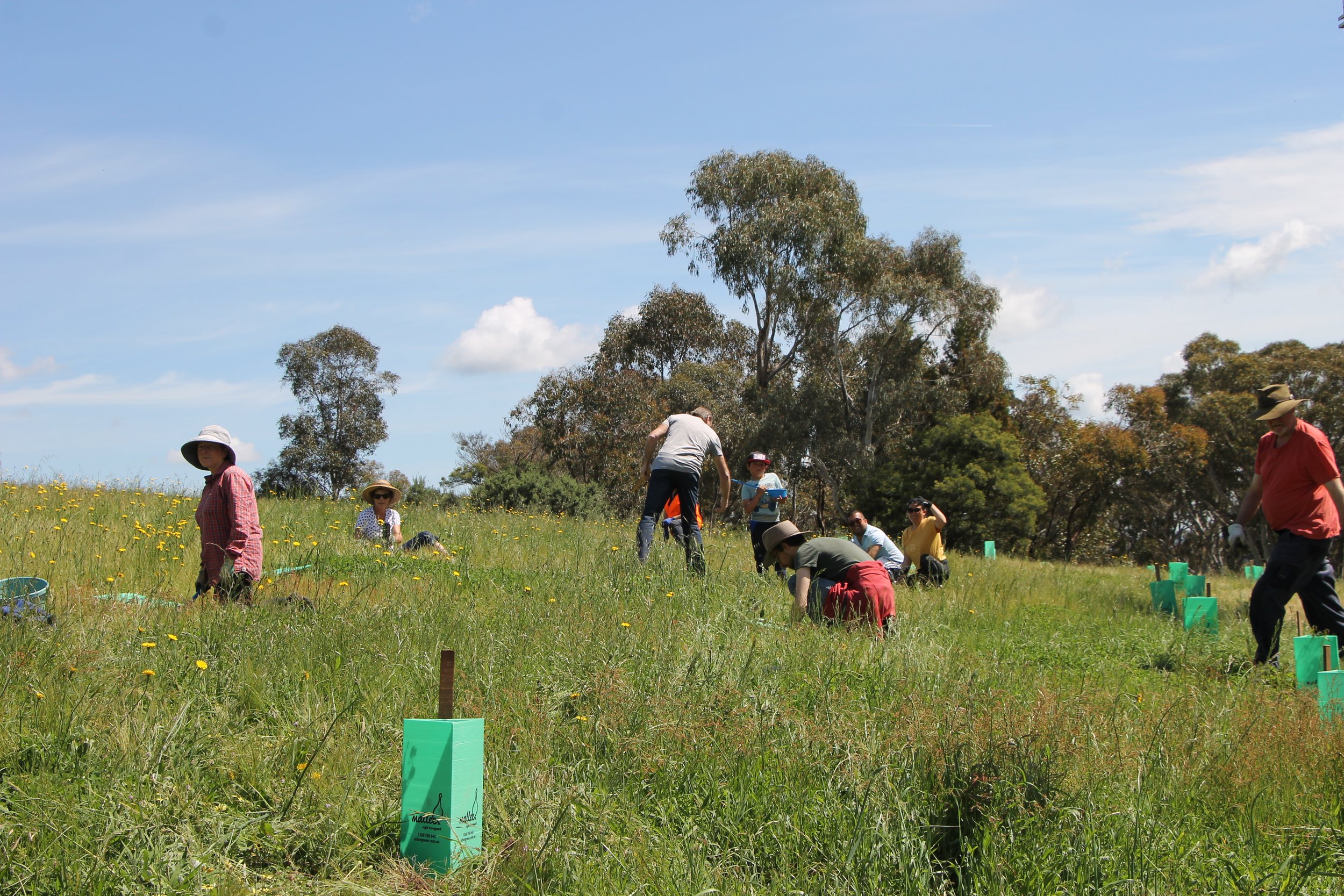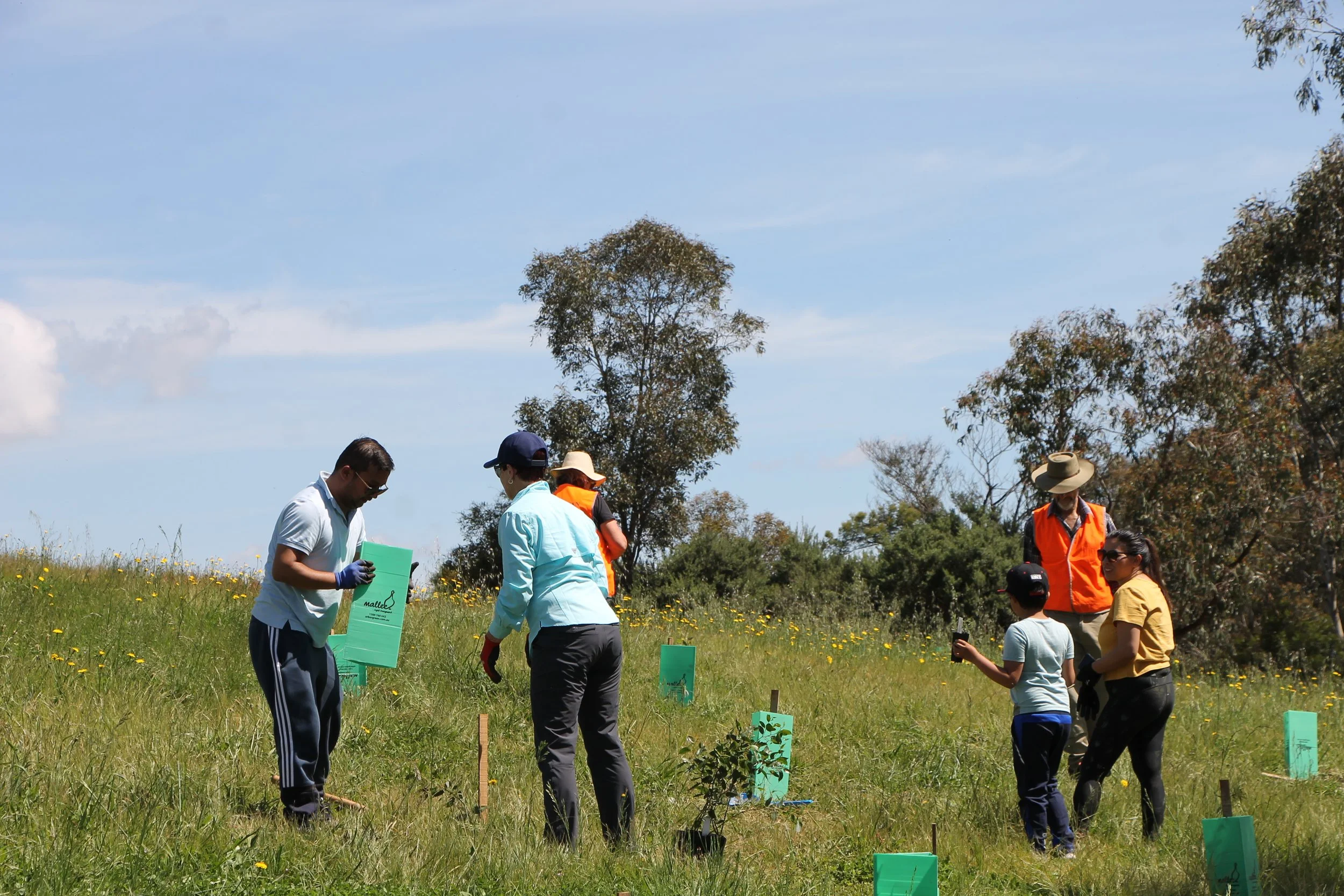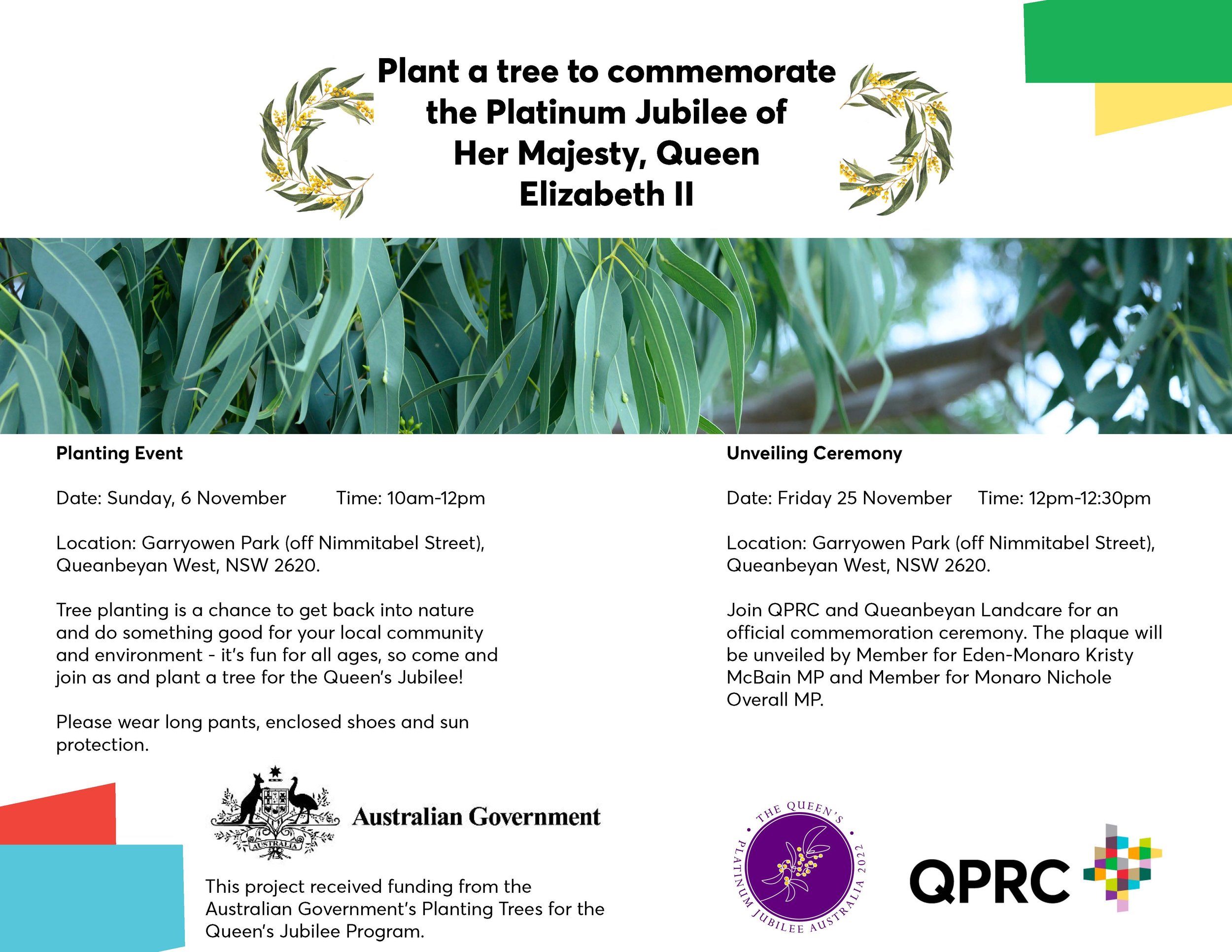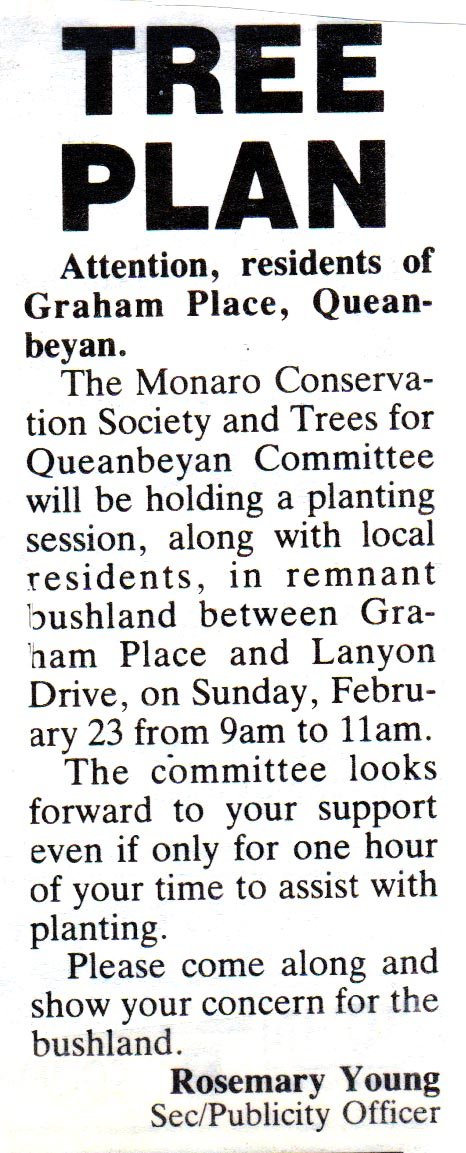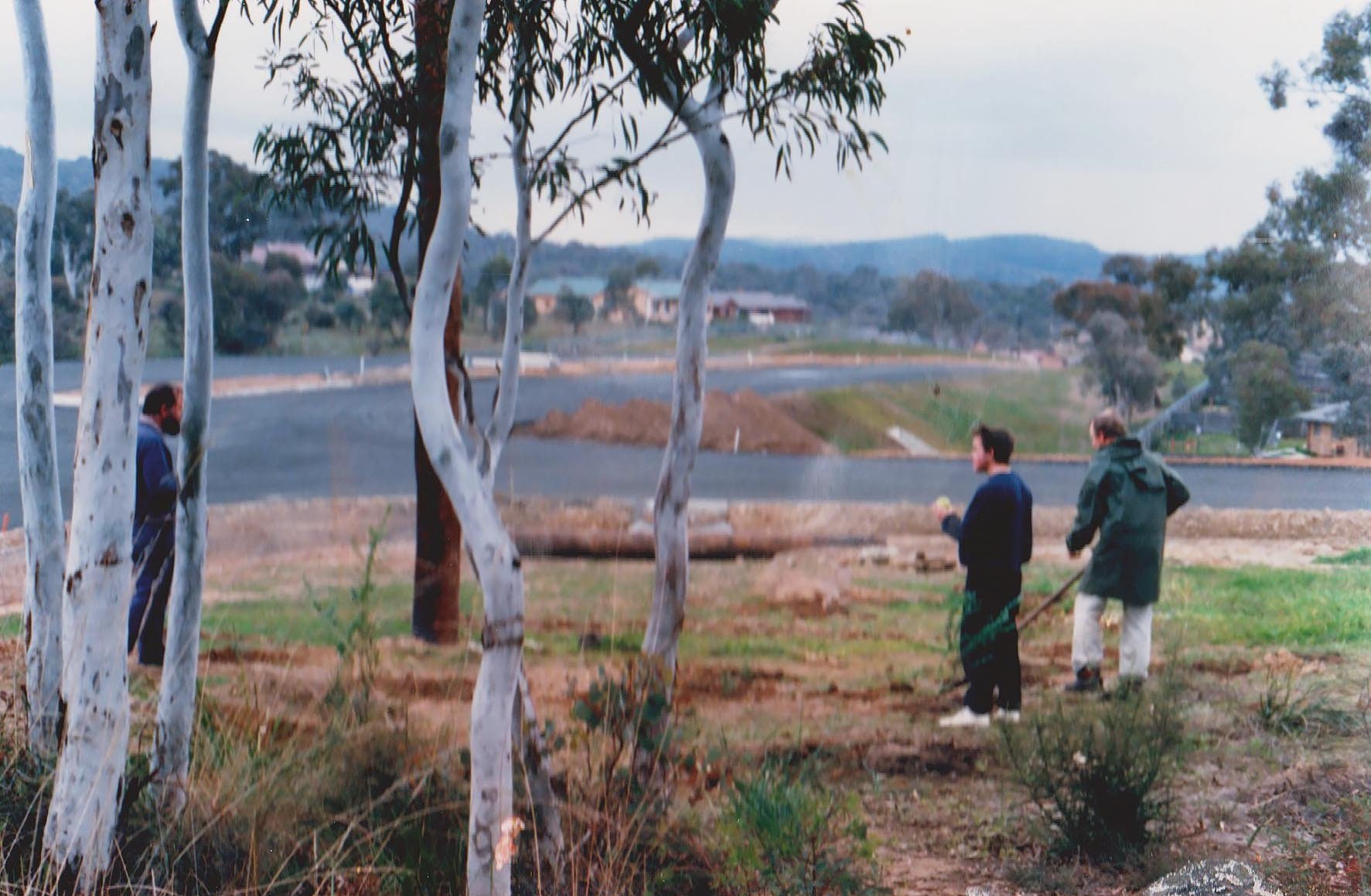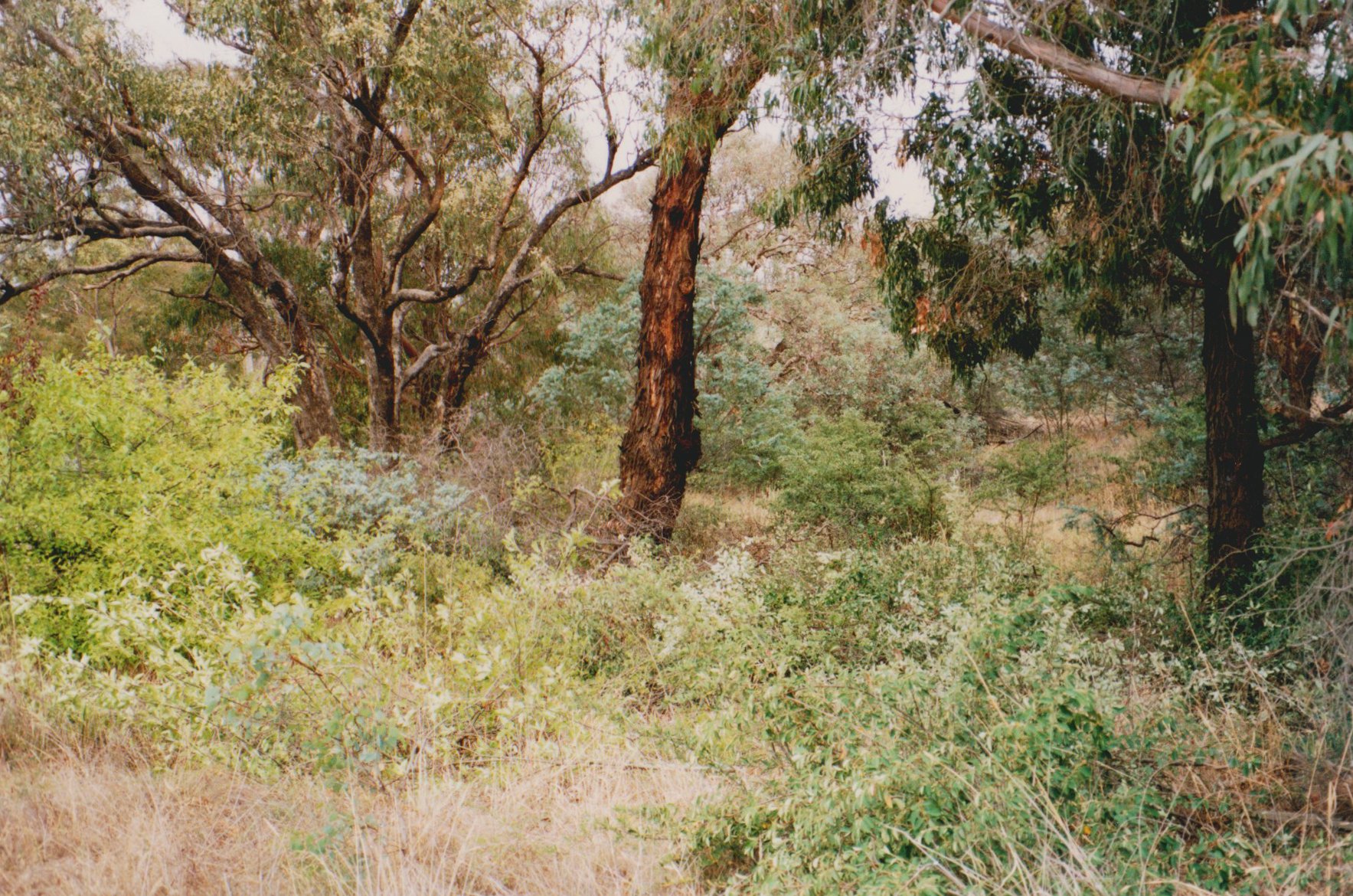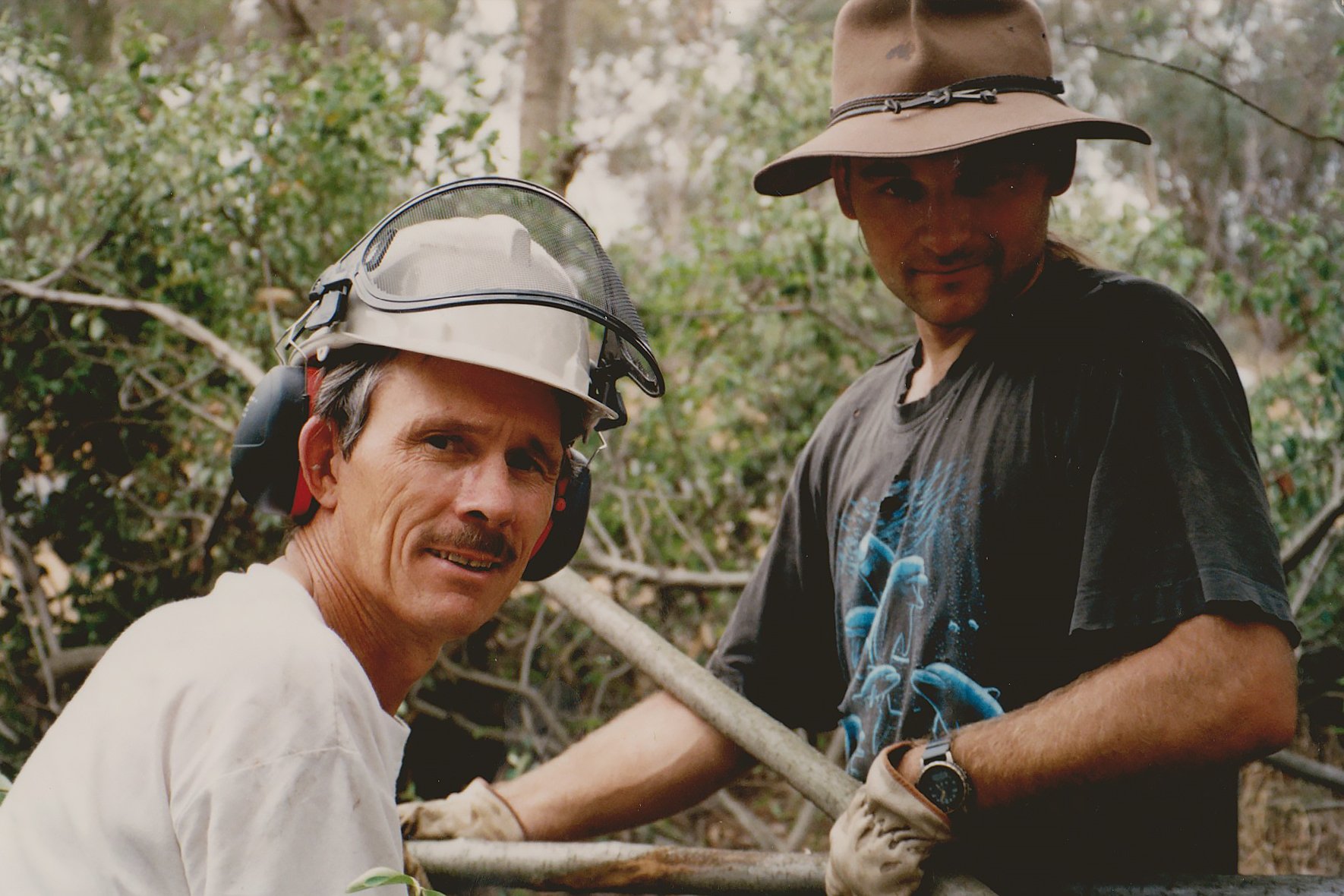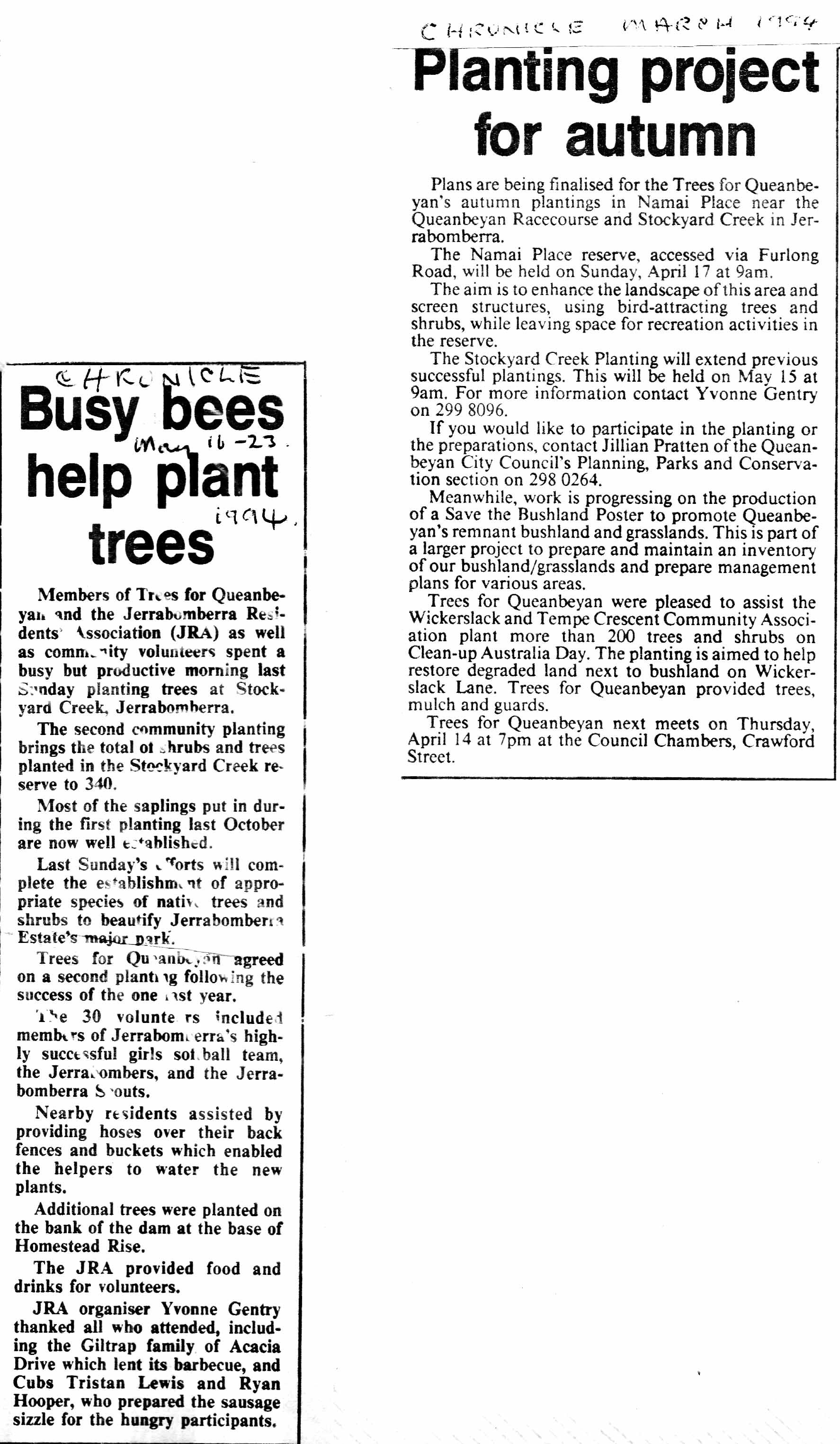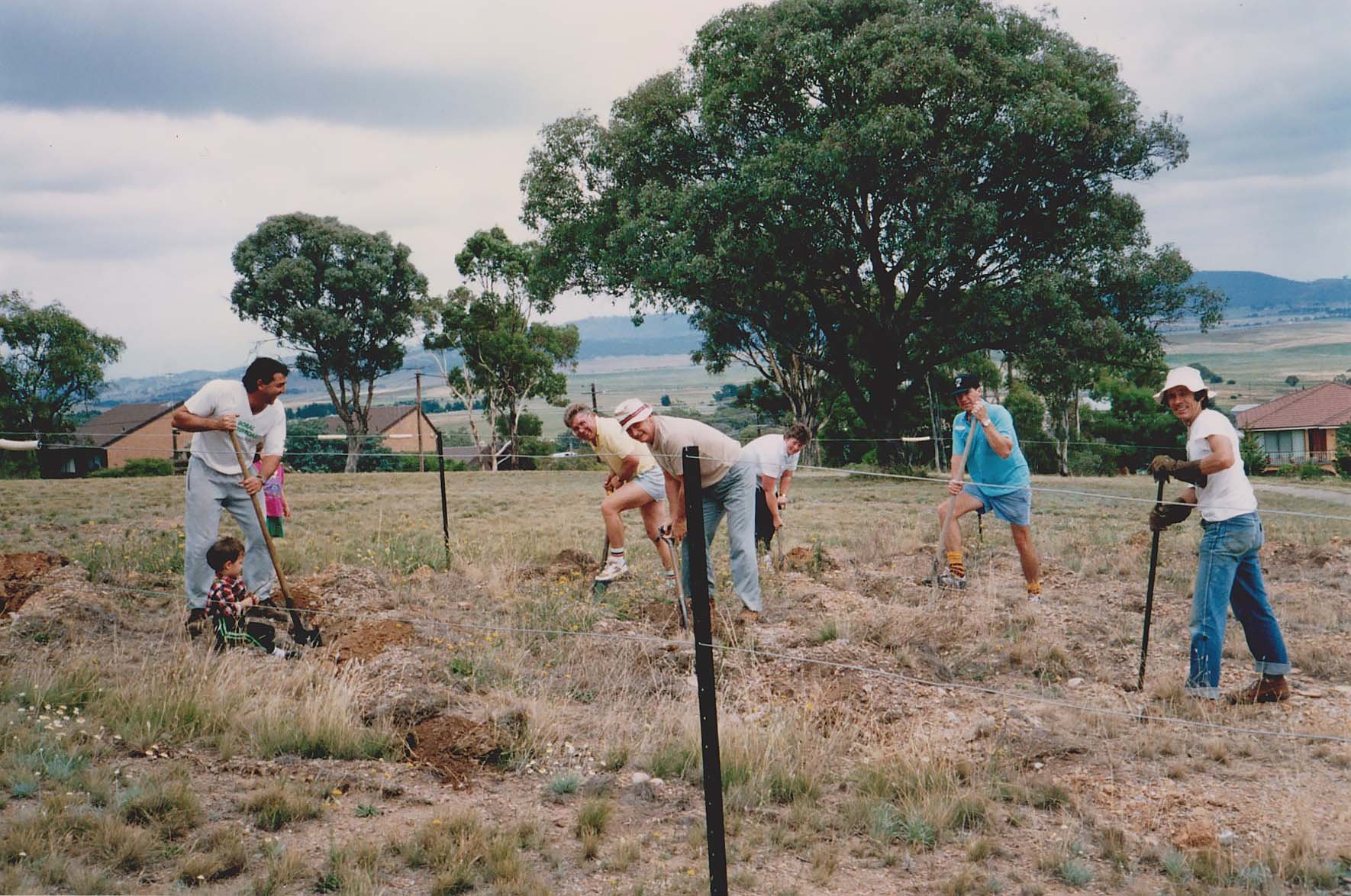
History Project Stories
West Queanbeyan
Remnant Bushland
MORE THAN THE SUM OF THEIR PARTS:
BUSHLAND REMNANTS IN WEST QUEANBEYAN
Queanbeyan Landcare’s projects over the years have created valuable scenic, recreational and conservation assets across the district. However, many add up to more than just a scatter of valuable places but create stepping stones and corridors of natural vegetation to assist the movement of native wildlife. Many small birds, mammals and reptiles require continuous vegetation to move about the landscape and survive, or at least only small distances between cover. This involves revegetation and habitat protection across different patches of land, tenures, land uses and landowners, in a collaborative fashion, where each action and patch of land combines to be ‘more than the sum of the parts’.
This approach is known as ‘connectivity conservation’ and is described in an open access chapter in the main global protected areas management handbook. Some connectivity projects are at large, even continental scale: such as in our area the Great Eastern Ranges project which seeks collaboration and conservation outcomes right along the mountain ranges of eastern Australia (https://ger.org.au/). Many are smaller, but in themselves part of something larger such as the GER.
Over many years Trees for Queanbeyan and the Monaro Conservation Society and later Queanbeyan Landcare have worked with partners to retain or create continuous native vegetation areas stretching across West Queanbeyan towards Mount Jerrabomberra, through the following small plantings and reserves:
Garryowen Park
Graham Place / Nimmitabel Street Bushland Reserve
Freebody Oval, Queanbeyan Kangaroo Rugby League Football Club
McRae Street, Letchworth Regional Park
Henderson Road, Queanbeyan Railway Station,
Queanbeyan Community GardensNamai Place
Winchester Place, Southbar Road, NorthEast of
Mount Jerrabomberra ReserveJohn Bull Reserve
Bicentennial Park (More on it’s History here)
At an interview in 2021, Queanbeyan Landcare stalwart Tom Baker spoke of a string of bushland remnants across West Queanbeyan:
‘The first project of Queanbeyan Landcare, actually the Monaro Conservation Society and Trees for Queanbeyan, started with work on bushland near Nimmitabel Street. Rubbish was removed. There are photos in the album stored in Queanbeyan Library. This area connects in a southerly direction with Bicentennial Park under Lanyon Drive, onto Winchester Reserve and then to Mount Jerrabomberra. Going north Graham Place was planted through Trees for Queanbeyan, then there is Bald Hill (now Garryowen Park). The next area was the bush between John Bull Street and Canberra Avenue, which was largely native grassland with orchids but now has turned into a spindly open dry forest called John Bull Reserve. The next was a piece of bushland in West Queanbeyan Primary School, not sure if that is there now’.
In June 2022 as part of an email trail between members of Queanbeyan Landcare discussing Bicentennial Park, Tom wrote this:
Re: the string of reserves across West Queanbeyan, there is also the patch in the West Queanbeyan Primary School and then the railway reserve vegetation and small patch near the Letchworth Community Centre. There was also a planting at Freebody Oval by the Trees for Queanbeyan group and the Club, near the Kangaroo Club.
Clearly Tom and others sought to increase the connectivity between these reserves and remnants, and to build a larger conservation asset connecting the bigger areas of habitat at Mount Jerrabomberra and Bicentennial Park as shown on the map.
So while the stories of each patch and project below seem to be individual stories, they should be read as parts of a greater whole.
Garryowen Park
Identified as Trig site No. 459 Garryowen Park is one of three main high features within the city. It has an outstanding view of the city and surrounds especially the commencement of the Limestone Plains. It was originally known as Bald Hill but in 1995 Queanbeyan City Council formally renamed the area Garryowen Park.
In March 1991 the Trees for Queanbeyan Committee was approached by a resident of Nimmitabel Street who suggested that if the Committee organise a planting, then she would maintain the plantings. Meagan Cousins and Alvina Dark (Trees for Queanbeyan and Queanbeyan City Council) then spoke to several residents in the area and having received good community responses organised a committee inspection on 6 May 1991.
Tim Booth started sourcing the equipment required, Greening Australia became involved in preparation of a draft plan to be presented to Council, Soil Conservation services were consulted, and a leaflet was prepared and then delivered to residents. The grant application for the ‘One Billion Trees Program’ indicated that the existing trees on the site were ‘single and clumped mature Eucalyptus rossii, mcrrorhyncha and blakeleyi’. The leaflet included an invitation to a meeting to discuss the proposed plan, and the initial tree planting on Sunday 4 August 1991 in Bald Hill Carpark was a success with over 30 locals attending. Greening Australian donated the trees.
At the Trees for Queanbeyan meeting held on 7 August 1991 Meagan Cousins (Queanbeyan City Council and Trees for Queanbeyan) tabled the landscaping plan for the remainder of the park. A subcommittee was formed comprising Tim Booth, Kerrie Ruth, Bob Ogilvie and Tom Baker with acknowledgement that Allan Moss from Council would be the contact re the approval for any plans.
Collection and propagation of local seed was a priority for the group, however the seed was not ripe by 27 Oct 1991, the day organised for collection, so it was purchased by the Committee, propagated by the Council and with assistance from Queanebeyan Landcare members the seedlings were potting up prior to planting.
There was an ongoing request to Council for assistance with fencing and the removal of the water tank. In a letter to Council from Tim Booth on Nov 6, 1991 it was stated that:
The trees here will all be local native species that will thrive there and require minimal ongoing maintenance. They will be placed in 5 or 6 copses with large areas of open space between them and well back from adjacent houses and gardens so as not to encroach on private land. Before planting, the ground will be ripped by a bulldozer and fences will be erected to protect the young seedlings in their initial years. Once established the fences will be removed.
In 1992 weeds were sprayed, fences installed and the seeds collected by Garry Orr (Queanbeyan’s own phantom tree planter) germinated. The March 1992 Minutes indicate that everyone on the Committee had a role in ensuring the success of the planting day, from the purchase of buckets and spades, organising a water tanker, arranging a letter drop, collecting seed and providing refreshments. Over 40 residents turned up for the planting. The Presidents Report of 1992 indicated that a total of 900 trees had been planted at Garryowen Park.
Throughout the planning for planting on Garryowen the Committee had hoped to use locally sourced native grass seed and when this did not happen, they looked to purchasing seed. They could only source Wallaby Grass seed and given its price at the time a decision was made to encourage self-germination of grasses already growing on the park.
Disappointingly in April 1993 it was reported that over 25% of the plantings have been whipper snipped (presumably accidentally by Council workers). The Committee discussed the need for marker pegs, tree guards. By June Tim Booth had planted about 150 replacement trees.
A note indicates that in 2000 Green Corp recruits conducted maintenance on the planting at Bald Hill. The reserve was still often referred to as Bald Hill well after the name change in 1995 with some residents still using this name. Many newspaper articles or even Queanbeyan Landcare minutes incorrectly refer to this area as Gary Owen or Garry Owen Reserve.
On Sunday 6 November 2022 Queanbeyan Palerang Regional Council held a community tree planting for the Queen Elizabeth Platinum Jubilee program at Garryowen Park. The new plantings were extensive and ringed the lower portion of the Park near the main carpark off Nimmitabel Street. The native grasses that are to the west of the park were avoided.
Members of Queanbeyan Landcare joined the planting and were also in attendance at the official ceremony organised by QPRC where a plaque that is now firmly attached to a large rock near the carpark was revealed. A selection of Grevilleas were planted near the rock.
The Honorable Kristy McBain MP, Nicole Overall MP, Kenrick Winchester (mayor of QPRC), Esma Livermore (Deputy Mayor), members of QPRC and Queanbeyan Landcare and local residents attended.
QPRC recognised the role of Queanbeyan Landcare at Garryowen Park and developed a poster to acknowledge this.
More Garryowen history is shown in the Gallery below

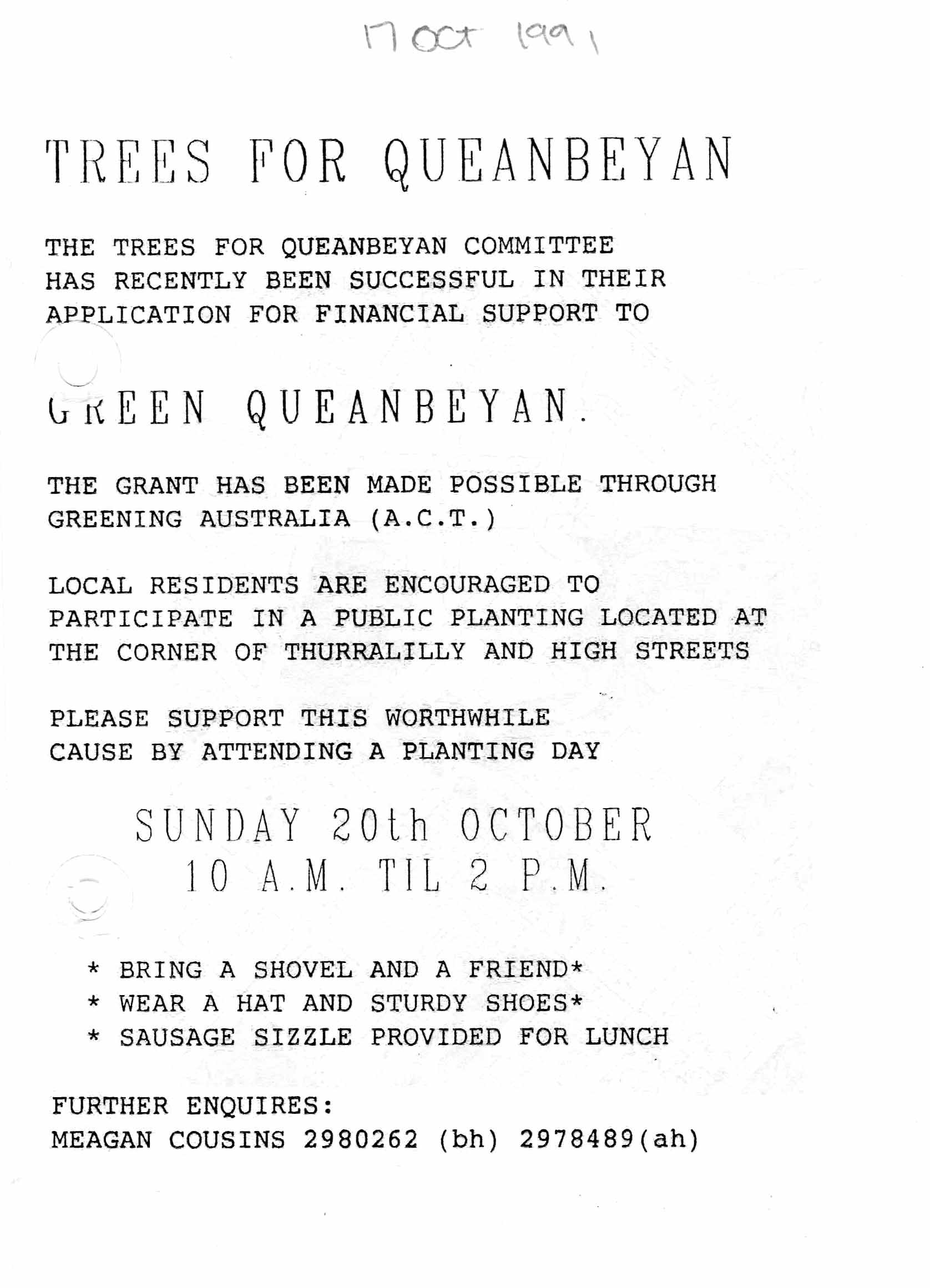



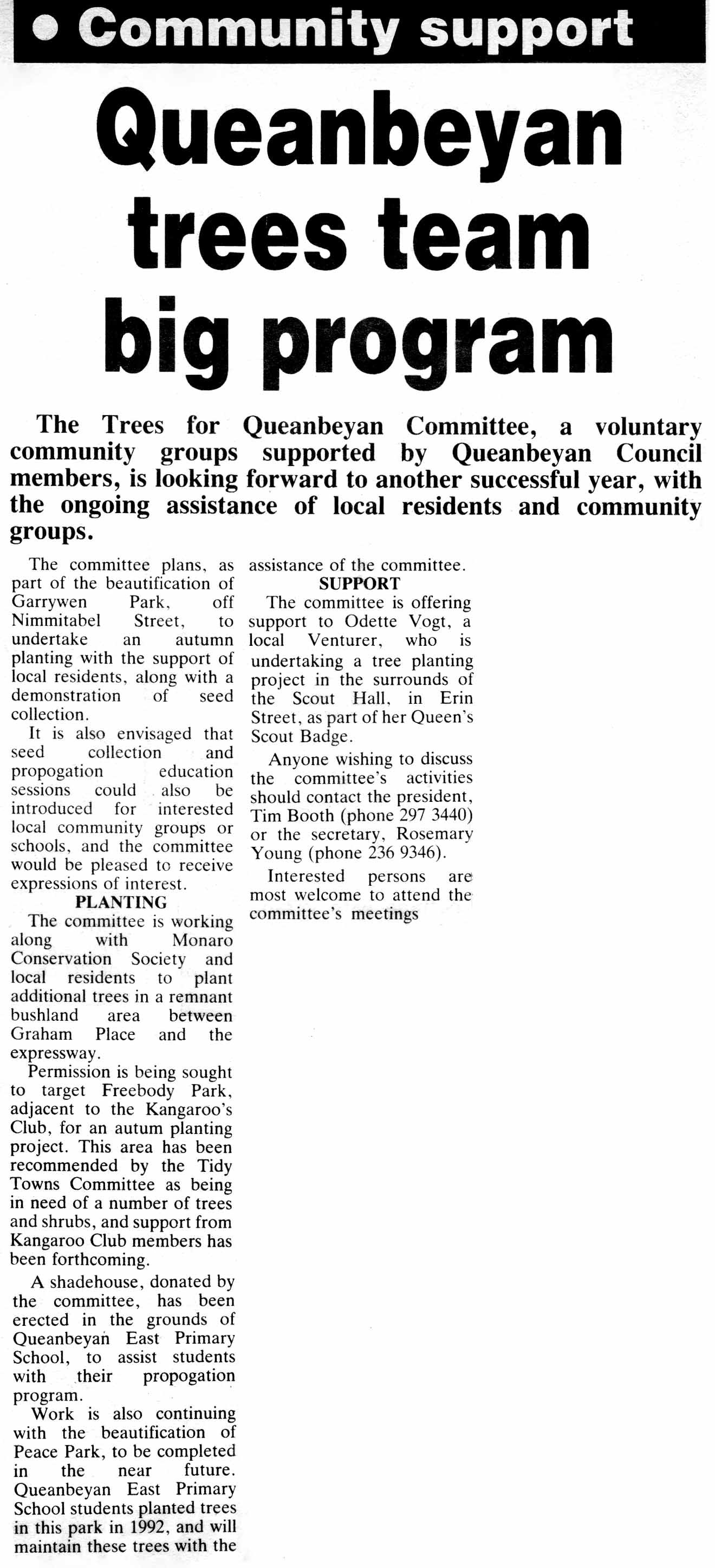
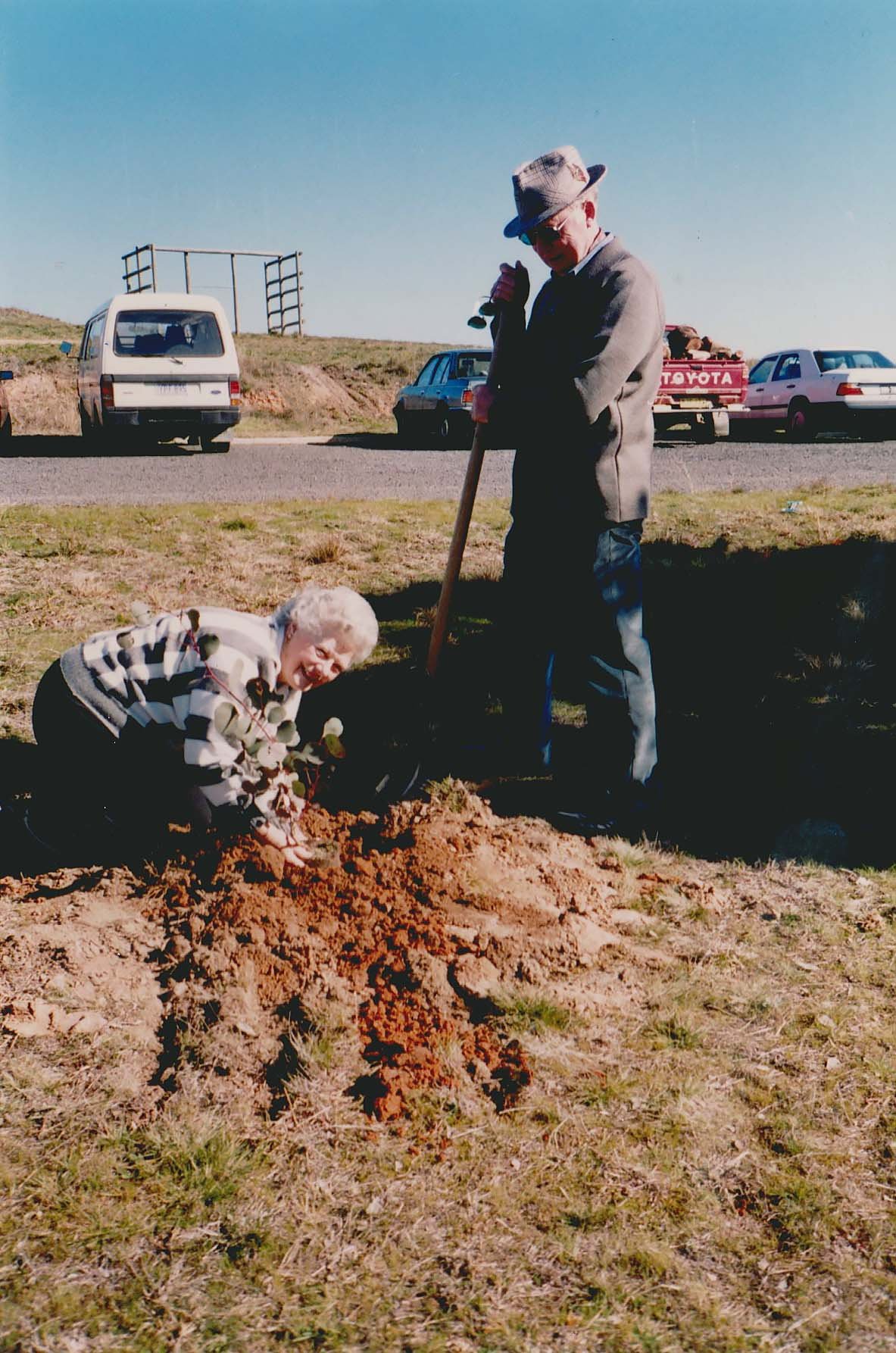
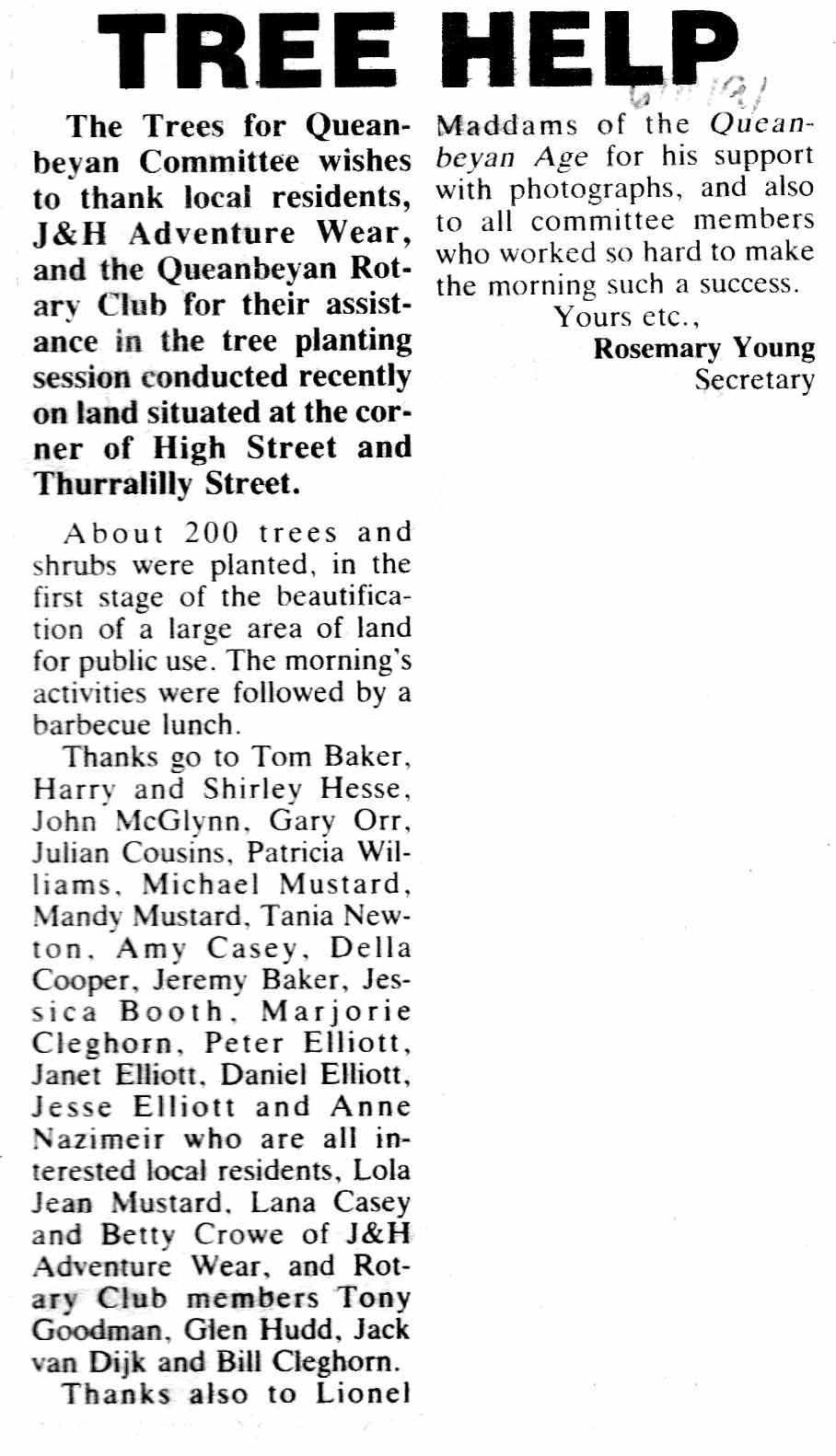
Graham Place, Nimmitabel Street Bushland Reserve
The small area of bush adjacent to Graham Place and Nimmitabel Street was identified as site for consideration by Trees for Queanbeyan in 1991. Ripping took place early in 1992 and on Sunday 23 February 1992 plantings by members of Trees for Queanbeyan, the Monaro Conservation Society and local residents took place. The group planned to reassess the success of the planting in spring 1992.
In 1992 residents near the corner of Nimmitabel Street and Graham Place became aware that a 20 metre high Optus base transceiver station was to be erected in the nearby public bushland reserve. The Monaro Conservation Society and many of the residents wrote to Council outlining their objections and expressing support for maintaining the reserve and recognizing its natural heritage value.
The August 1993 Minutes discuss the damage to the Graham Place planting and the need to erect vehicle proof barriers. The group wrote to the Council on this matter.
Green Corps recruits installed bollarding and signage, carried out mulching, path work and more planting of endemic species in the area in 2000.
Freebody Oval, Queanbeyan Kangaroo Rugby League Football Club
In 1992, permission was sought and gained for revegetation activities at Freebody Park, adjacent to the Queanbeyan Kangaroo Rugby League Football Club for an autumn planting. This area had already been recommended by the Tidy Towns Committee as being in need of a number of trees and shrubs, and support from Kangaroo Club members had been forthcoming.
A large community planting occurred in April 1992. In May of the same year Queanbeyan Landcare thanked the Kangaroo Club for its involvement in the planting session. They discussed the need to remind the Club of an ongoing watering and weeding regime, and by November the Club was requesting a maintenance morning with assistance from Club members. The 1992 President’s Report indicated that 400 trees were planted at the Football Club.
McRae Street,
Letchworth Regional Park
In 1992, Molonglo Consevation Society was concerned about the impact of a proposed subdivision in West Queanbeyan. The development, located between Lanyon Drive and McRae Street (Stage 4, Site 7910) would impact remnant bushland. Molonglo Conservation Society proposed that a strip of the nature reserve be maintained along Lanyon Drive, identifying many benefits including slowing the continual loss of natural bushland, providing some noise abatement to the houses that were to be built and creating a pleasant and interesting place to live. A survey of residents supported this proposal with many commenting that they had not received any advice about the Department of Housing plans for the area and were outraged that there was a plan to erect a high fence along Lanyon Drive and destroy the bushland they had used for many years.
Initially Council had supported the development but that was eventually withdrawn. In the 21st December 1992 edition of the Queanbeyan Age, Alderman Harry Hesse stated:
‘This is a late attempt to change Council’s recommendation to the Department of Housing, following a petition from about 120 residents calling for such a move. Unfortunately, it is probably too late’.
In March 1993 the Minister for Housing and Minister for Planning, Robert Webster made it clear that they would adopt most of the original proposal but made a few concessions about the number of trees that would remain and a provision to plant the remaining strip with native plants and construct landscaped mounds in front of the fence. While not a great victory for conservation, at least some visual and habitat concessions were achieved.
Discussions continued with the Department of Housing about some of the bushland. The Department agreed to a proposal from the Monaro Conservation Society in 1996 to create a small bushland reserve on the corner of Hellmund and McRae Street (near the entrance to the Queanbeyan Race Club Racecourse and adjacent to Letchworth Regional Park). This was bollarded and the Monaro Conservation Society carried out a number of projects to stem erosion, remove invasive exotic plants and conduct more native plantings. Work by the group was completed in 1996.
Henderson Road,
Queanbeyan Railway Station, Queanbeyan Community Gardens
A resident of Henderson Road, John Hession, suggested Trees for Queanbeyan consider planting along the northern side (between road and railway) of Henderson Road from Young St to Crest Road. Meagan Cousins suggested a planting of thick shrubs rather than trees. Planting details were discussed at the September meeting, but the planting proposed for 13 September 1992 did not occur as the intentions of Council regarding the area were unclear.
The Minutes from October 1995 indicate that a request was made for help with scout planting at the railway yard on Henderson Road. The Committee agreed to support this with 100 local native trees and shrubs. Small native trees were ultimately planted along this reserve.
The Monaro Conservation Society entered into an agreement with Trains NSW in 2002 to upgrade and maintain the landscaping of Queanbeyan Railway Station carpark. For approximately fifteen years, the Society visited the site monthly, to control invasive plants, plant natives, collect rubbish, trim trees and repair the front fence, restore signage and trim the very large hedge along the rail-line near the Stationmaster House. The Society received a payment each six months, to cover costs, including materials and insurance.
Funds generated from this work contributed to a fund of about $10,000 which was transferred to Queanbeyan Landcare in 2012 after the Monaro Conservation Society formally ceased all its activities in 2011. Queanbeyan Landcare continued the monthly maintenance days. A large planting of natives was carried out by NSW Trains in about 2017 along the platform towards Canberra and this was also maintained by Queanbeyan Landcare. Queanbeyan Landcare continued this maintenance work until 2019 when NSW Trains employed CBM Contractors to undertake maintenance of railway property across the State. Queanbeyan Landcare was unable to fulfil some of the requirements to continue this work.
Queanbeyan Landcare also assisted with two small native planting at the Community Gardens in Henderson Road. This coincided with the creation of the Henderson Road Recreation facility nearby.
[Images: Top - Before Woody Weeds Removal | Middle - After Weed Removal |
Lower - Tom Baker & Phil Selmes.]
Namai Place
Namai Place is first mentioned in the Minutes of Trees for Queanbeyan in July 1993 when a planting was proposed. In October an inspection of the site was organised with all invited to attend and discuss the proposed planting.
The following year at the April meeting it was noted that Bernard Baz, a local resident who had originally proposed the planting, had been door knocking for support. It was agreed at that meeting that the trees would be planted on 17 April 1994 and would not be planted with gel (a water storing jelly often deposited at the time of planting) given the recent rain and the upcoming winter season. The May meeting reported a successful planting of over 120 plants with good community support and a BBQ.
In the Canberra Chronicle, March 1994 an article about the The Namai Place Reserve stated,
‘…aim is to enhance the landscape of the area and screen structures using bird-attracting trees and shrubs, while leaving space for recreational activities in the Reserve.’
Winchester Place Reserve,
Southbar Road, North East of
Mount Jerrabomberra Reserve
In 1994 a local resident, Geoff Lovie attended a meeting of Trees for Queanbeyan to find out about planting at bush reserve at the end of Winchester Place. A planting was arranged for 20 Nov 1994 with the February 1995 Minutes indicating that a successful planting occurred. The reserve is mentioned in later Minutes after a local resident approached Queanbeyan Landcare for information about the control of the weed, Dodder.
John Bull Reserve
The December 1996 Minutes of Queanbeyan Landcare identify John Bull Reserve as a site of interest. It was described as a low maintenance Urban Bush Reserve that would not require much maintenance by Council but has problems with woody weeds such as Cootamundra Wattle and Cotoneaster.
QLc considered preparing a plan of management for the reserve and held an inspection prior to the February 1997 meeting. Issues identified included control of Kunzea ericoides, fire issues, unauthorised vehicle access, dumping of rubbish including glass, concrete and gravel, weeds and exotic trees.
The plan was not produced as at the time the QCC was producing a generic POM for Urban Bushland Reserves.
In 2000 Green Corps recruits collected native grass seed at John Bull Park.
This summary was produced in 2022 by referring to the Minutes of Trees for Queanbeyan and Queanbeyan Landcare, while also consulting the personal recollections of Tom Baker, Tim Booth, Kerrie Ruth and John McGlynn.








